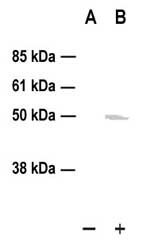PC386
PhosphoDetect Anti-p53 (pSer¹⁵) (Ab-3) Rabbit pAb
liquid, Calbiochem®
About This Item
Origine biologica
rabbit
Livello qualitativo
Forma dell’anticorpo
affinity isolated antibody
Tipo di anticorpo
primary antibodies
Clone
polyclonal
Forma fisica
liquid
non contiene
preservative
Reattività contro le specie
rat, mouse, human
Produttore/marchio commerciale
Calbiochem®
Condizioni di stoccaggio
OK to freeze
Isotipo
IgG
Condizioni di spedizione
wet ice
Temperatura di conservazione
−20°C
modifica post-traduzionali bersaglio
phosphorylation (pSer15)
Informazioni sul gene
human ... TP53(7157)
Descrizione generale
Immunogeno
Applicazioni

Immunoblotting (1:1000)
Immunoprecipitation (1:200)
Attenzione
Stato fisico
Ricostituzione
Risultati analitici
PC-12, HCT116, or HeLa cells treated with DNA damaging agents
Altre note
Levine, A.J. 1997. Cell88, 323.
Milczarek, G.J., et al. 1997. Life Sci.60, 1.
Shieh, S.Y., et al. 1997. Cell91, 325.
Meek, D.W. 1994. Semin Cancer Biol.5, 203.
Note legali
Non trovi il prodotto giusto?
Prova il nostro Motore di ricerca dei prodotti.
Codice della classe di stoccaggio
10 - Combustible liquids
Classe di pericolosità dell'acqua (WGK)
WGK 2
Certificati d'analisi (COA)
Cerca il Certificati d'analisi (COA) digitando il numero di lotto/batch corrispondente. I numeri di lotto o di batch sono stampati sull'etichetta dei prodotti dopo la parola ‘Lotto’ o ‘Batch’.
Possiedi già questo prodotto?
I documenti relativi ai prodotti acquistati recentemente sono disponibili nell’Archivio dei documenti.
Il team dei nostri ricercatori vanta grande esperienza in tutte le aree della ricerca quali Life Science, scienza dei materiali, sintesi chimica, cromatografia, discipline analitiche, ecc..
Contatta l'Assistenza Tecnica.